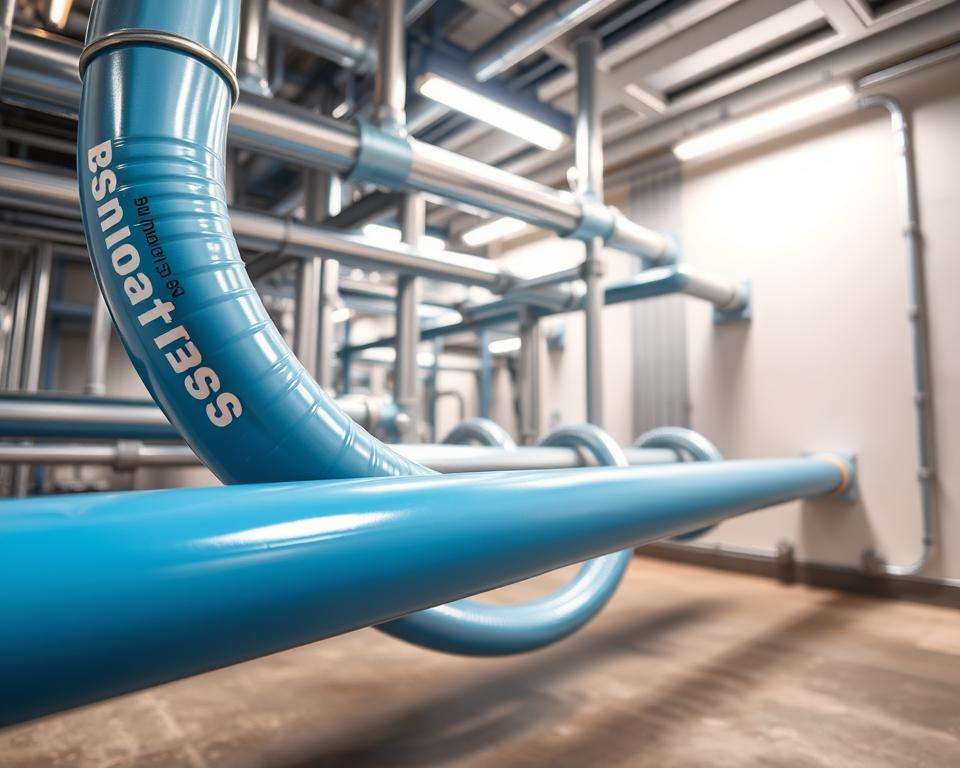Your Complete Guide to PVC Pipe in Compressed Air Systems
Did you know that a ruptured compressed air system can release energy equivalent to a stick of dynamite? Despite the hazards, numerous workshops continue installing piping systems from unsafe materials. This guide explains why safety should come first when using PVC pipe for air compressor lines.
Although some plastics gain popularity, OSHA flatly forbids their above-ground application. Repeated contact with compressor oil and thermal cycling makes them brittle, causing explosive failures. Even at “safe” pressure ratings, the risk of explosions remains high.
Turn to Installation Parts Supply for sturdy aluminum systems. Investing in proper materials avoids costly fines and keeps workplaces secure. Here’s how to assemble a risk-free system.

Core Insights
- OSHA prohibits specific piping for air lines because of blast hazards.
- Heat and cold swings slashes claimed pressure capacity.
- Material becomes brittle with age, upping rupture chances.
- Switching to aluminum vastly improves safety.
- Invest wisely to dodge fines and protect staff.
Why You Shouldn’t Use PVC for Compressed Air
All major brands advise against certain plastics in compressed air. Unlike water, compressed air stores explosive energy—a ruptured line can release force comparable to dynamite. Material selection is the linchpin of air-system safety.
- Brittleness: Cold snaps make pipe walls brittle and prone to cracking.
- Adhesive failures: Temperature changes and oils cause adhesive joints to fail.
- Misleading ratings: Most shops run above 110°F, slashing rated pressure in two.
After a PVC burst hurt staff, OSHA levied a $110,000 fine. Compression heating lowers allowable pressure even more—often ignored.
“Above-ground use of certain plastics for compressed air violates OSHA standards due to explosion risks.”
Steel and aluminum curve under stress instead of shattering. PVC shards fly far and fast, causing collateral damage.
Workshops face daily temperature fluctuations that accelerate material degradation. A decade’s UV and chemical attack weakens plastic, so small leaks too often balloon into disasters.
Best Materials Instead of PVC for Air Lines
Aluminum air lines deliver superior safety and leak reduction. Black pipe vs. aluminum: aluminum wins with 90% fewer leaks. Lightweight, rust-proof aluminum stands up to years of service.
Snap-together modular aluminum cuts installation hours. Installation Parts Supply stocks ready-to-snap aluminum modules. A Midwest auto plant cut labor costs by 40% after switching to this system.
- Copper: Best for cleanrooms due to natural antimicrobial properties. Requires soldering expertise.
- Stainless Steel: In seaside shops, stainless steel won’t corrode.
- ABS/HDPE: Chemical-resistant for labs and factories handling solvents.
“Our aluminum retrofit reduced energy waste by 15%—paying for itself in 18 months.”
Torque matters. Cracks from overtightening and leaks from under-tightening are common. Stick to recommended 25–30 ft-lb torque for aluminum.
NSF-approved lines keep food-grade air clean. Always match materials to your environment’s demands.
How to Choose the Right Piping Material for Your Needs
Consider cost, compliance, and efficiency in your pipe decision. One plant slashed $12k per year by adopting aluminum lines. Here’s how to make the right choice.
| Material | Cost (per ft) | Maintenance | ROI Time |
|---|---|---|---|
| Aluminum | $8.50 | Low | 18 months |
| Black Pipe | $5.00 | High | N/A |
| Copper | $10.20 | Medium | 24 months |
Temperature matters. Aluminum handles -40°F to 200°F, while plastics crack below freezing. For chemical-heavy environments, stainless steel resists solvents.
Pro Tip: Compute ROI based on compressed-air leakage. A 10% leak in a 50 HP system wastes $3,500 yearly.
- Don’t undersize—pick pipe rated at or above your compressor’s PSI.
- Check OSHA compliance for weld inspections and pressure tests.
- Request a free system audit from Installation Parts Supply.
“Our aluminum retrofit cut energy waste by 15%—paying for itself in 18 months.”
Small shops can DIY, but experts deliver guaranteed seals. Always verify warranty terms—some materials cover 10+ years.
Conclusion
Choosing the right materials for your compressed air setup isn’t just about cost—it’s about safety. Older systems account for 92% of accidents due to degraded piping. Aluminum offers 99.8% reliability, making it a smart long-term choice.
Key takeaways:
- Say no to plastics that can explode.
- Opt for corrosion-resistant metals like aluminum or stainless steel.
- Ignoring standards invites fines and insurance headaches.
Ready to upgrade? Grab same-day pricing and deals on kits from Installation Parts Supply. Request your free template or emergency service today.
Make safety your piping priority—act today.


